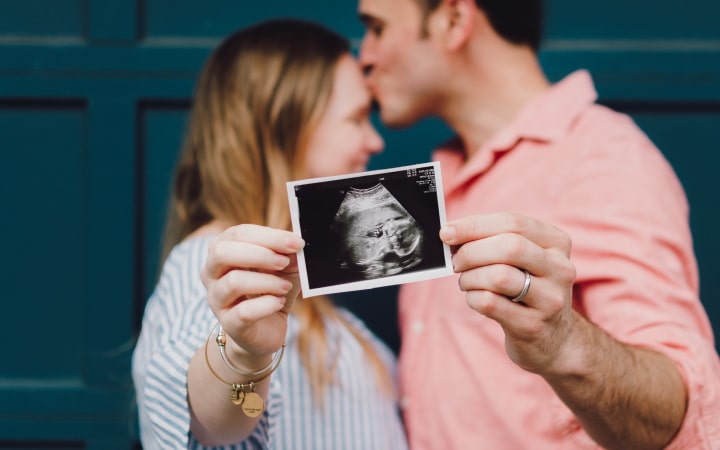
About 3D and 4D baby ultrasound
Table of Contents
An ultrasound allows both a doctor and a mother to see a baby during the woman’s pregnancy. It has no psychological effects on the baby but it gives a valuable insight into the baby’s development.
3D and 4D baby ultrasound basics

3D baby ultrasound is a medical ultrasound technique, often used in obstetric ultrasonography (during pregnancy), providing three-dimensional images of the fetus.
There are several different scanning modes in medical and obstetric ultrasound. The standard common obstetric diagnostic mode is 2D scanning. In 3D fetal scanning, however, instead of the sound waves being sent straight down and reflected back, they are sent at different angles. The returning echoes are processed by a sophisticated computer program resulting in a reconstructed three-dimensional volume image of the fetus’s surface or internal organs, in much the same way as a CT scan machine constructs a CT scan image from multiple x-rays. 3D ultrasounds allow one to see the width, height, and depth of images in much the same way as 3D movies but no movement is shown.
An ultrasound is a machine that allows you to see your baby during your pregnancy. A sonogram is a picture taken of your baby during the ultrasound. A sonogram is a “still-shot” of your baby. 4D Ultrasounds take 3D ultrasound images, or 3D sonograms, and add the element of time to the process. The result: Live-Action ultrasound images of your baby. Some people refer to the procedure as prenatal imaging, 3D imaging, a 3D scan, or 4D scan.
Objective
To assess the clinical value of a novel three-dimensional (3D) ultrasound technique, the reverse face view (3D RF view), in the antenatal categorization of facial clefting and in particular clefting of the hard palate.
Methods
Eight cases of suspected orofacial clefting were examined by 3D surface rendering. The fetal lips and alveolar ridge were examined in the frontal plane and the face was then rotated through 180° on the vertical axis to examine the secondary palate by the 3D RF view.
Results
In each case described, we were able to visualize the fetal face, lips, and palate and make an antenatal diagnosis as to whether the palate was affected. In all cases, the antenatal diagnosis was subsequently confirmed. In one case with a left-sided cleft in the lips and alveolar ridge and an intact hard palate, the correct diagnosis was made but a cleft in the soft palate was missed.

Conclusion
Although clefts of the lips and alveolar ridge are readily diagnosed on high-quality antenatal ultrasound, visualization of the fetal palate using existing techniques is unreliable. In the patients described here, the 3D RF technique allowed a relatively straightforward assessment of the fetal palate with a high degree of accuracy.
The purpose of the present research was to investigate the role of the fourth-dimensional (4D) ultrasound scanning on antenatal attachment development, in pregnant women (19–23 weeks of gestation) and their partners. A total of 44 couples were asked to complete questionnaires about maternal and paternal antenatal attachment, before the two-dimensional (2D; control group) and 4D (experimental group) ultrasound scanning and 2 weeks later. In the groups of women, our findings underline the progressive increase in antenatal attachment throughout gestation: the mean level of antenatal attachment was significantly different between the first and the second assessment. No significant differences are shown between 2D and 4D baby ultrasound scanning groups. We do not eliminate the possibility that ultrasound scanning practice would be a helpful and crucial means of investigation for a complete explanation of prenatal attachment.

Maternal-fetal attachment or bonding is a natural phenomenon that develops gradually throughout pregnancy and peaks in the few weeks after the birth of the child. It is regarded as an essential process in the development of good and loving motherly behavior.
1. In about 8% of women, this process is sub-optimal, with potentially damaging effects on the mother-infant relationship and on the emotional development of the child.
2. Factors associated with abnormally low attachment are depression, lack of social support, and a domineering partner.
3. Prior to the introduction of real-time ultrasound, antenatal bonding was literally kick-started by the onset of fetal movements.
4 and intensified during the third trimester as the mother responded to the distinct patterns of rest and activity transmitted to her by her unborn baby1. It is now widely accepted that the early routine scans at 12 and 20 weeks are the main factors involved in initiating this bonding process.
5–7, although, disappointingly, ultrasound has not been shown to intensify this process in the third trimester.
8. Furthermore, it has not yet been demonstrated that ultrasound can make a positive impact on pregnant women with sub-optimal prenatal attachment.
The benefits of 2D and 4D baby ultrasound
3D and 4D baby ultrasound gives great chances for both doctors and parents not to only see a baby but also to see if it has any anomalies. It is great in preventing babies from being born with defects.
